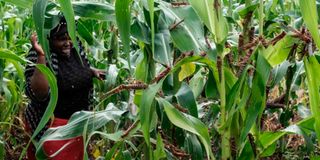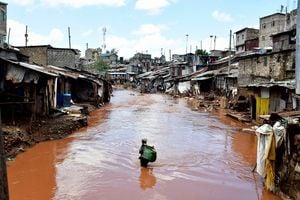How one can avoid total crop failure

A farmer desperately attempts to chase eating her maize plants in Meru county on February 8, 2021. If not addressed fast, pests and diseases can destroy farmers’ crops and livelihoods.
In the previous article, a farmer complained that her French bean production failed, leading to losses.
There are times yields are significantly lower than the projected returns per unit area.
Crop damage from pests and diseases, bad weather and poor management play a role in such failure.
Crop failure hits a farmer’s revenue and reduces the amount of food available for consumption, leading to hunger.
A majority of crop failure necessitates preventive measures early in the production cycle.
We listened to the farmer to understand her predicament. We also took notes as she explained what happened that led to her crops failing.
We then pinpointed some of the reasons that contributed to the problem.
We could tell that her tilling during land preparation was minimal.
The farmer’s previous crop was cabbage. Due to the dry season after the rains, the soil had formed hard pans.
This affected seed germination and the development of roots, thus lowering the plant population.
Second-generation seeds
Secondly, the farmer used untreated second-generation seeds. This had an impact on germination percentage and the ability of the seeds to resist pests and diseases.
Gapping, which is the replacement of seeds that failed to take off after the germination, was not done.
We also could tell that some of her seeds were hit by pests and diseases. Farmers need to know that the use of certified seeds helps reduce incidences of pest and disease during the early stages of growth.
Thirdly, some seeds aborted after germination due to inadequate watering. Most of the drip line emitters were blocked.
The problem could have been solved by unblocking the lines through flushing. We informed the farmer that flushing would have ensured a uniform distribution of water to her crops.
Inadequate irrigation during the vegetative stage causes stunted growth. It also leads to a dark green colouration. Less water causes the flowers to abort, resulting in the absence of pods.
Drought can cause a rain-fed crop to fail, requiring intervention or the installation of an irrigation system.
In the event of heavy rainfall, floods are likely to be experienced on the farm. These can uproot crops and carry them away. It is important to ensure your drainage system is working.
Pests
Changes in weather conditions also facilitate an attack on the crops by pests and diseases. These include rust.
Pests and diseases not detected and dealt with early enough lead to crop failure.
Finally, her farm operator was unskilled. The farmhand did not understand the significance of timely management practices and interventions.
The seeds, for instance, were planted without fertiliser. Top dressing fertiliser was not applied at the right time.
We also found out that there were weeds on her farm. Weeds compete with crops for nutrients. They also harbour pests and diseases.
This resulted in stunted growth. The farmer’s French beans developed deformed pods, rendering them unmarketable.
Eventually, the farmer did not get any yields.
Efficient management practices can go a long way in stopping crop failure. Irene’s French new crop of beans are developing pods.
We shall look at the management practices to be carried out at this stage in our next article.





